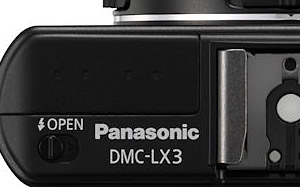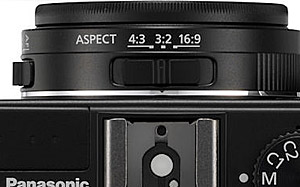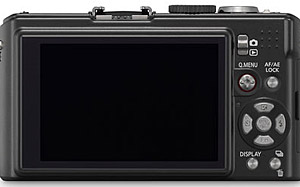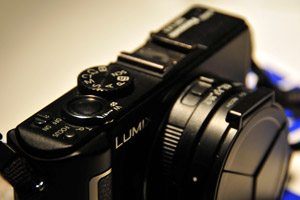 Part one of the Lumix LX3 review gave you the tech specs, part two got into the meat, this final part wraps it up with more detail, provides the summary and scores.
Part one of the Lumix LX3 review gave you the tech specs, part two got into the meat, this final part wraps it up with more detail, provides the summary and scores.
Flash
Activated via a small switch on the top plate and standing taller than some of its rivals, the LX3’s small built-in flash offers Auto, Auto with red-eye reduction, Forced on and Slow sync with red-eye reduction in auto mode. Flash compensation can be selected via the up button, and there’s also an option to set up rear-curtain sync for some arty effects.
Like all decent prosumer compacts, there’s a hotshoe onboard which can take the optional DMW-FL360 or DMW-FL500 flashguns, although they’re disappointingly priced.
The DMW-FL360 starts at around a hefty £170 and the DMW-FL500 positively attacks your wallet at around £320. It’s a real shame Panasonic don’t supply a cheaper and more compact external flash gun for the LX3 as both of these will dwarf the camera and make it uncomfortably top heavy. Sort it out, Panasonic!
Exposure options
In line with its enthusiast/pro leanings, the LX3 packs in a host of exposure options, giving users complete control via Manual, Aperture or Shutter Priority modes, with the maximum f2.0 aperture usable all the way up to 1/2000.
The joystick can be used to quickly make adjustments in Aperture or Shutter Priority modes, with pushes in different directions letting you alter exposure settings on the fly. It’s a little fiddly at first, but we got the hang of it pretty quick.
Night photographers are particularly well served by the LX3 with a gloom-illuminating maximum exposure time of 8 seconds in Aperture or Shutter Priority, and a mighty 60 seconds in Manual or the Starry Sky preset.
 When it comes to scene presets, the Lumix covers just about everything short of Biblical conditions and alien invasions, with a choice of no less than 24 options of varying usefulness (we don’t think we’ll be needing the Food, Party, Candle Light, Baby1 and Baby2 presets any time soon), but the real star of the show is the Lumix’s superb Intelligent Auto (iA) mode.
When it comes to scene presets, the Lumix covers just about everything short of Biblical conditions and alien invasions, with a choice of no less than 24 options of varying usefulness (we don’t think we’ll be needing the Food, Party, Candle Light, Baby1 and Baby2 presets any time soon), but the real star of the show is the Lumix’s superb Intelligent Auto (iA) mode.
Intelligent Auto (iA)
This employs a heady mix of Intelligent Scene Detection, Intelligent ISO and Intelligent Exposure to work out what kind of scene it’s looking at, and then sets the exposure accordingly.
The mode icon in the top corner changes to reflect the calculated scene and we found this was unnervingly accurate – at a fireworks show, we pointed it at the night sky and it switched to ‘starry night’ – but as soon as a few rockets went off, it changed to ‘fireworks’ mode. Very neat.
The Intelligent Auto mode can also call upon Optical Image Stabiliser, face detection, quick AF and digital red-eye correction too and we found it worked superbly well and is probably the smartest automatic mode we’ve ever tested.
 Image quality
Image quality
We were extremely pleased with the quality of the photos taken on the LX3. We found the Intelligent Auto mode to be so, well, intelligent, that we grew increasingly confident in its ability to handle tricky lighting situations that we left it switched on for a lot of our shooting.
Photographs were bright, crisp, well exposed displaying above average dynamic range with excellent colour reproduction. Any suspicion of a slight softness in some images was easily remedied in Photoshop.
Noise was a vast improvement on previous LX models, with images noise-free at ISO 80, 100 and 200, and only starting to creep in at ISO 400.
At ISO 800 things got a bit noisier with some loss of fine detail – especially in shadow areas – although still usable for smaller prints. Into the heady heights of ISO 16000 and 3200 things got as noisy as you might expect, with image quality suffering major deterioration. There is also an optional High Sensitivity mode that goes up to Alpine peaks of ISO 6400, but that’s really unusable unless you’re outputting to a postage stamp print.
Although some may find the reds and oranges a bit on the bright side, there was virtually no sign of chromatic aberration or purple fringing and the white balance was accurate throughout (and easily adjustable).
The 720p HD video recording is a nice touch for a camera so small, and the results were rather impressive, although it’ll never replace a proper camcorder.
 Conclusion
Conclusion
We’ll come straight out and say it: we loved this camera. For serious photographers, the feature list is nigh on perfect with lots of manual and creative controls, good ergonomics, a sensible megapixel count, RAW file support and a superfast lens with a useful wide angle range.
Although the 24-60mm zoom range may be restricting for some, we found it to be a decent compromise for the quality of the lens on offer, providing a perfectly usable range for street snappers and everyday shooting.
The new 10 megapixel sensor was a big improvement on other Panasonic compacts, and the fast f2.0 lens and optical stabiliser should help keep you the noisy fug of the high ISO settings at bay.
Overall we found the LX3 to be a well-made, great looking, carry-everywhere camera with a superbly effective auto mode backed up by a comprehensive suite of manual controls.
Highly recommended.
Rating
Ease of use: 86%
Picture quality: 90%
Features: 91%
Value for money: 84%
Overall: 91%
Specifications
Image Sensor 10.1 Mega pixels
Sensor Size 1/1.63″
Optic
Zoom Factor Optical Zoom 2.5x
 Extra Optical Zoom 4:3 Aspect Ratio: 3.0x for 7Mega, 3.6x for 5Mega, 4.5x for 3Mega, 2Mega, 0.3Mega 3:2 Aspect Ratio: 3.0x for 6.5Mega, 3.6x for 4.5Mega, 4.5x for 3Mega, 2.5Mega 16:9 Aspect Ratio: 3.0x for 6Mega, 3.6x for 4.5Mega, 4.5x for 2.5Mega, 2Mega
Extra Optical Zoom 4:3 Aspect Ratio: 3.0x for 7Mega, 3.6x for 5Mega, 4.5x for 3Mega, 2Mega, 0.3Mega 3:2 Aspect Ratio: 3.0x for 6.5Mega, 3.6x for 4.5Mega, 4.5x for 3Mega, 2.5Mega 16:9 Aspect Ratio: 3.0x for 6Mega, 3.6x for 4.5Mega, 4.5x for 2.5Mega, 2Mega
Digital Zoom 4x ( Max. 10.0 x combined with Optical Zoom without Extra Optical Zoom ) (Max. 17.9x combined with Extra Optical Zoom)
Focal Distance f=5.1-12.8mm (35mm Equiv.: 24-60mm)
Lens LEICA DC VARIO-SUMMICRON 8 elements in 6 groups (4 Aspherical Lenses / 4 Aspherical surfaces)
Aperture Wide: F2.0 – F8.0 Tele: F2.8 – F8
Optical Image Stabilizer MEGA O.I.S. (Auto/Mode1/ Mode2)
Conversion lens Compatibility Yes
Focusing Area Normal: Wide 50cm/ Tele 50cm – infinity / Intelligent AUTO / Macro: Wide 1cm / Tele 30cm – infinity
AF Metering Face / AF tracking / multi-area / 1-area high speed / 1-area / spot
Focus/Exposure
Focus Mode Normal / Macro, Quick AF On/Off (On in Intelligent Auto), Continuous AF On/Off AF/MF Switchable, Manual Focus(Joystick), One Shot AF, AF Area Select, AF Tracking
AF Assist Lamp Yes
ISO Sensitivity Auto / 80 / 100 / 200 / 400 / 800 / 1600 / 3200 (High Sensitivity Mode : Auto(1600 – 6400) )
ISO Limit Set Yes
White Balance Auto / Daylight / Cloudy / Shade / Flash / Halogen / Color Temperature / White Set 1 / White Set 2 / (Selectable at Portrait, Soft Skin, Transform, Self-Portrait, Sports, Baby1, Baby2, Pet, High Sensitivity, Hi-Speed Burst, Pinhole modes) / White Balance Adjustment (2-axis adjustable, ±9steps each, Blue/Amber and Magenta/Green bias)
Exposure Program AE, Aperture Priority AE, Shutter Priority AE, Manual, Program Shift(Program AE mode)
Exposure Compensation 1/3 EV step, +/-2 EV
Backlight Compensation Yes (auto in Intelligent AUTO mode)
Multi-Exposure Yes
Multi-Aspect Yes
Auto (AE) Bracketing +/- 1/3 EV ~1EV step, 3 frames
Light Metering Intelligent Multiple / Centre Weighted / Spot
Rec Mode[Mode Dial] Intelligent AUTO, P(Program) mode, A(AperturePriority) mode, S(Shutter Priority) mode, M(Manual) mode, Motion Picture, Custom1, Custom2, Scene mode
Scene Mode Portrait, Soft Skin, Self-Portrait, Scenery, Sports, Night Portrait, Night Scenery, Food, Party, Candle Light, Baby1, Baby2, Pet, Sunset, High sensitivity, Starry Sky, Fireworks, Beach, Snow, Aerial photo, Hi-Speed Burst, Flash-Burst, Film Grain, Pin Hole
Shutter Speed P:1-1/2000sec (Selectable minimum shutter speed) A/S:8-1/2000sec, M:60-1/2000sec Starry Sky Mode : 15, 30, 60sec.
Flash System
Built-in-Flash Auto, Auto/Red-eye Reduction, Forced On, Slow Sync./Red-eye Reduction, Forced Off / Flash Synchro ; 1st / 2nd / Flash output Adjustment (1/3EV step, -2 – +2 EV) / 0.8 – 8.3m (Wide/Macro/ISO Auto), 0.3 – 5.9m (Tele/ISO Auto)
Self Timer 2sec, 10sec
Auto Review 1sec, 2sec, Zoom, Hold
Review 1x, 4x, 8x
Picture Adjustment Contrast: ±2steps / Sharpness: ±2steps / Saturation: ±2steps / Noise Reduction: ±2steps / (can be adjusted in Film Mode)
Film Mode Standard, Dynamic, Natural, Smooth, Vibrant, Nostalgic, WB/Standard, WB/Dynamic, WB/Smooth, My Film1, MyFilm2, Multi Film
Recording Format Still Image: JPEG(Design rule for Camera File system, based on Exif 2.21 standard), RAW, DPOF corresponding / image with audio: JPEG (Design rule for Camera File system, based on Exif 2.21 standard)+ QuickTime / Motion picture: QuickTime Motion JPEG
Recording Image Size Still Image: 4:3 Aspect Ratio: 3648x 2736 pixels, 3072 x 2304 pixels, 2560 x 1920 pixels, 2048 x 1536 pixels, 1600 x 1200 pixels, 640 x 480 pixels / 3:2 Aspect Ratio: 3776 x 2520 pixels, 3168 x 2112 pixels, 2656 x 1768 pixels, 2112 x 1408pixels, 2048 x 1360 pixels / 16:9 Aspect Ratio: 3968 x 2232 pixels, 3328 x 1872 pixels, 2784 x 1568 pixels, 2208 x 1248 pixels, 1920 x 1080
Image Quality Fine / Standard / RAW / RAW+Standard JPEG / RAW+Fine JPEG
Motion Picture 4:3 Aspect Ratio: 640 x 480 pixels 30 fps, 320 x 240 pixels 30 fps/10 fps / 16:9 Aspect Ratio: 848 x 480 pixels 30 fps / HD(16:9 Aspect Ratio): 1280×720 pixels 24fps
Burst Shooting Mode Full-Resolution Image, 2.5 frames/sec Max. 8 images (Standard mode), Max 4 images (Fine), Max 3images (RAW) / High-speed Burst Mode: approx. 6 frames/sec (recorded in 3M for 4:3, 2.5M for 3:2, 2M for 16:9)
Unlimited Consecutive Shooting yes
Digital Red Eye Correction yes
Intelligent Exposure yes
Intelligent Exposure_ Off / Low / Standard / High
Still Image Rec. with Audio 5 sec
Audio Dubbing Max. 10sec
Real-time Histogram yes
Highlight Display Yes
Composition Guide line yes
Composition Guide line_ 2 patterns
Built-in-Memory [Capacity] approx. 50MB
Scene Mode Help Screen yes
Auto Angle Detection yes
Travel Date yes
World Time yes
Title Edit yes
Text Stamp yes
LCD Monitor 3.0″, 3:2 Polycrystalline TFT LCD Display (460K dots) / Field of View : approx. 100% / AUTO Power LCD mode, Power LCD mode
Playback mode [REC]/[Play] Selector switch / 30-thumbnail display, 12-thumbnail display, calendar display, zoomed playback (16x max.), Playback of favourite pictures, Category Playback (playback and slideshow of pictures in category) / Slide show (duration and effect with music is selectable), image rotation / Resizing (selectable number of pixels), trimming, protection, aspect conv. DPOF print setting / Creating still pictures from a motion picture, Dual image playback / Enlarge focus area, image leveling
Category Playback playback and slideshow of pictures in category
Slideshow Mode (duration & effect with music is selectable), image rotation
Recording Media Built-in Memory, SD Memory Card, SDHC Memory Card, MultiMediaCard(Still image only)
Microphone yes
Speaker yes
Interface DC Input, AV Output (NTSC/PAL), HD AV Output (Component), USB2.0 High speed
Direct Print PictBridge
Battery Li-ion Battery Pack (3.7V, 1150mAh) (Included)
AC Adaptor AC Adaptor (Input: 110-240V AC) (Optional)
Battery life (approx.) 380 pictures (CIPA standard)
Dimensions [mm]
Width 108.7
Height 59.5
Depth 27.1
Weight [g]
Body 290.0
Including Battery and SD Memory Card 265.0
Included Software PHOTOfunSTUDIO -viewer- 2.1E / ArcSoft (MediaImpression / Panorama Maker) / SilkyPix Developer Studio 3.0SE / QuickTime / USB Driver
Standard Accessories Battery Charger / Battery Pack / Battery carrying case / AV Cable / USB Connection Cable / AC Cable Strap / CD-ROM
Comments
4 responses to “Lumix LX3 Review: High End Digital Compact Camera (pt. 3)”
[…] The more details and conclusion are available in part 3 of the Lumix LX3 Review. […]
[…] Source and Read More: digital-lifestyles.info […]
Thanks for an excellent review. Just one thing. The mode dial does include two Custom Modes, but C2 has 3 modes (C2-1 C2-2, C2-3)), so you actually have 4 custom modes available.
Thanks again for a fine review.
Regards,
Frank B
I recently got one of these (in black), and I concur – it’s a superb little camera. The iA mode is outstanding, too.
I replaced the previous “low light king,” the Fujifilm F31, with the LX3, and I’m not looking back. The “all auto” mode on the F31 jacked the ISO up to 800 way too easily, even with flash. The LX3’s “all auto” mode, Intelligent Auto, is actually very usable, and I leave the camera set to that mode when I put it away, so it’s ready for a fast shot if I need one. With flash shots, it usually sets ISO to 100 – very usable.
Mostly, I use it in Program mode at ISO 80, Nostalgic film mode, RAW+jpg, and I get wonderful results.
This is a great piece of, er, “kit,” as you lot across the pond say :-) (I’m in the US).
BTW, this camera is so deep that I usually pick up a nice tip from each review. In your review, I learned a bit about the “up arrow” button, and the bracketing menu it brings up. Thanks for that :-)